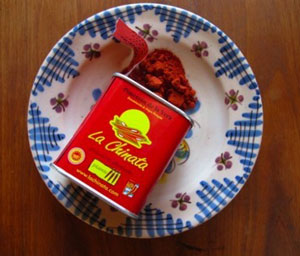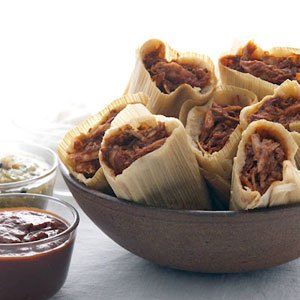 |
Spicy Pumpkin Seeds – Great with beer Classic Margarita – Blending is not allowed. Lila’s Guacamole – The best way to eat green. Huevos alla Amy – A breakfast treat. Tortilla Soup - In case it's still cold in your neck of the woods. Topopo Salad – A salad of volcanic proportions. Ceviche – Cool and refreshing. Enchiladas Suizas – Simply delicious. Mexican Chicken – Spicing it up. Goat Cheese and Poblano Quesadillas with Pineapple-Habanero Salsa - For those who like it HOT! Grilled Steak Tacos with Watermelon-Mango-Jicama Salsa - It's not a celebration without tacos & salsa. |
Global Cuisine
Global Cuisine
Oven Baked Pulled Pork Flautas
 This recipe as a weapon of mass deliciousness. It’s easy to make and serve for a house full of your friends and family.
This recipe as a weapon of mass deliciousness. It’s easy to make and serve for a house full of your friends and family.
I have always thought of flautas as a specialty dish, one I would only order at a Mexican restaurant. Somewhere along the line I convinced myself flautas were complicated and I didn’t want to deal with the deep-frying. It’s not that I’m opposed to deep frying, but I knew it would be difficult and time-consuming to fry dozens of flautas for a large gathering.
However, I recently changed my mind and started working on perfecting baked flautas at home. I wanted the meat seasoned properly with traditional Mexican flavors. But most importantly, the flour tortilla had to have the perfect crunch. Anything less wouldn’t be right. I was looking for a flaky texture, similar to the deep-fried flauta.
Kofta Beef Kebabs
 It’s been a very, very short summer. I am not at all happy that 2 of my 3 kids are returning to school this Tuesday. WTF…it’s mid August! Packing lunches, getting up early(not a problem for me, but for them-YES), and routine is all part of this weeks drill.
It’s been a very, very short summer. I am not at all happy that 2 of my 3 kids are returning to school this Tuesday. WTF…it’s mid August! Packing lunches, getting up early(not a problem for me, but for them-YES), and routine is all part of this weeks drill.
Honestly speaking, I barely cooked this summer. It felt great to take a break, yet with school two days away it’s time for me to get back into the kitchen. Shopping, prepping, and organizing has filled my weekend. Cookies and brownies are made and frozen (perfect snack for the lunch box), farmers market organic fruits are flash frozen (great for morning smoothies), salad dressings are made and bottled, veggies are washed, meat and chicken are grilled (for easy sandwiches or simply served on their own), and the meal planning has begun!
Spending 30 or so minutes each morning on prep will allow me to get these nutritous and balanced meals on the table each night. Tonight’s dinner is one of my favorites. Combining all the ingredients in the morning allows the meat to marinate all day. Shaped into balls, skewered, and grilled, this is one of those perfect 30 minute meals.
Smoked Paprika, Meals with a Twist!
 I was recently asked by Heinz 57 Sauce and the folks at Good Bite what my favorite “flavor twist” was. They wanted to know what simple addition could be made to meals that would take them from simple to special. The answer was easy – Smoked Paprika.
I was recently asked by Heinz 57 Sauce and the folks at Good Bite what my favorite “flavor twist” was. They wanted to know what simple addition could be made to meals that would take them from simple to special. The answer was easy – Smoked Paprika.
Smoked Paprika, Pimenton de la Vera or Pimenton Ahumada comes from Eastern Spain. The red peppers are gently dried with smoke, usually from oak, before being processed into paprika. You can find it at fancy food markets, on-line and even in the spice rack at the supermarket. In fact, a McCormick rep told Bon Appetit Food Editor Sarah Tenaglia, that their jars of smoked paprika were one of their hottest sellers. So, I guess I’m not the only one who likes to add zip to dishes with Smoked Paprika.
The Spanish varieties, available in little tins, come in dulce – sweet or mild, and picante – hot. If you like things spicy, go for the picante, but a little cayenne pepper can be added to the dulce for the same effect. The tin pictured was a gift from my friend Pierre, who just returned from a trip to Spain.
Cooking Classes Your Way
 When it comes to cooking the food from another culture, the ingredients and techniques can be unfamiliar. Going to a foreign country and taking a cooking class is great, but not a readily accessible opportunity for most. Fortunately there are local cooking classes and cooking kits.
When it comes to cooking the food from another culture, the ingredients and techniques can be unfamiliar. Going to a foreign country and taking a cooking class is great, but not a readily accessible opportunity for most. Fortunately there are local cooking classes and cooking kits.
Recently launched Global Grub offers cooking kits with extremely well written instructions that will help you succeed in making things like sushi, or jerk chicken with coconut rice and beans. I used the tamales kit and was very impressed with the quality of the ingredients, the clear instructions and the wonderful results. My dad said the tamales were the best he'd ever eaten!
Kits include the dry and hard to find ingredients, and range in price from $13.99 up to $19.99 and for every kit purchased, Global Grub donates a meal to someone in need through their local food bank. Global Grub offers tutorial videos on their site, and the instructions with each kit are easily folded into a stand for easy reference as you cook.
More Articles ...
Welcome to the new One for the Table ...
Our Home Page will be different each time you arrive.
We're sure you'll find something to pique your interest...

